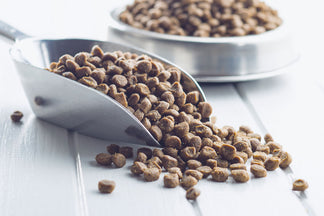What is really in your pet’s food? No matter what you personal pet food philosophy is, it is important to know what you’re buying. In the first part of this series (Cat Food Labels Explained Part 1), We explained what you can know about your pet’s food just from how it is named. In this post we show you how the ingredients list can tell you what to expect when you pop open that can.
The Process of Making Pet Food
Before we get started looking at the ingredients, it is important to have a basic understanding of how pet food is made. Cooking and processing can change how the ingredients work together and provide nutrition to your pet.
The Pet Food Institute has very simple graphics that represent the process of making dry pet food and the process of making wet pet food. Here are the basic steps in the processes:
Dry Pet Food
- The raw dry ingredients are ground up.
- The raw wet and dry ingredients are mixed together.
- The ingredients are cooked with steam.
- The ingredients are heated further while being shaped into the kibble pieces.
- The new kibble pieces are dried and cooled.
- Flavor enhancing coatings are added.
- The final product is packaged and made ready for delivery.
Wet Pet Food
- The raw ingredients are mixed together.
- The mixture of raw ingredients is separated into cans and the cans are sealed.
- The mixture of raw ingredients is cooked inside the can.
- The cooked pet food is cooled.
- The pet food cans receive their labels and are made ready for delivery.
What Does It All Mean?
On a pet food label’s ingredients list, all of the ingredients are listed according to weight. The ingredient that there is the most of in the mixture is first, the next most is second, and so on. In our example ingredients list, there is more poultry broth in the food than any other ingredient. You can also see that there is more chicken than there is liver.
It sounds pretty simple, right? Well, not exactly. Those measurements are taken before the food is cooked or processed – before step 1 of the process of making the food. During the cooking and processing of the food a lot of water is lost. Considering that raw meat is about 75% water, that could mean that the meat could move further down on the list if measurements were taken after the food was cooked. On our example label we can see that there was more chicken than there was whey gluten before the food was cooked. After being cooked there could be more whey gluten in the mixture than chicken because of the chicken’s water loss.
Every ingredient listed on the ingredients list must be listed by its “common name.” This “common name” is defined in The Official Publication of the AAFCO, but you have to purchase a copy ($125) in order to read those definitions. Here are two common, important pet food ingredient definitions to know:
Meat: “Clean flesh of slaughtered mammals and is limited to…the striate muscle…with or without the accompanying and overlying fat and the portions of the skin, sinew, nerve and blood vessels which normally accompany the flesh.” As noted above, raw meat is about 75% water.
Meat Meal: “The rendered product from mammal tissues, exclusive of any added blood, hair, horn, hide trimmings, manure, stomach and rumen contents.” When meat is made into meat meal, the water and fat are removed so that raw meat meal is only about 10% water.
Water isn’t the only thing that comes out during cooking. Vitamins and minerals can be lost in food as it is cooked. Pet food manufacturers replace the inherent vitamins that were lost during cooking with supplements. Those vitamins and minerals that are added back into the food must be added to the ingredients label using their chemical name. That is why you see so many strange names on the ingredients label. All of the vitamin and mineral supplement in our example are colored brown. The bad side of this is that the supplimental vitamins and minerals are not usually as easily used by your pets’ bodies.
Understanding Crude Analysis
The Crude Analysis on pet food label tells you the guaranteed minimum crude protein and fat, and the maximum percentage of fiber and moisture. Cat foods will often have the percentage of taurine, ash, and magnesium (these are not required by law). These measurements are after the food is cooked.
A few important words and phrases: The word “crude” refers to the method of testing the ingredients – not the ingredients themselves. “As is” measurements tell you the amounts that are in that can just the way it is. “Dry Matter” measurements help you compare nutrients between wet and dry foods.
Canned foods will always have more moisture than dry foods. As you can see in the process for making wet food, the moisture is sealed into the can so it is not lost from the mixture as a whole when it is cooked. A high moisture content is very important for cats.
A Few Notes on The Nutritional Adequacy Statement
Pet food manufacturers are required to meet certain government guidelines in order to say that a pet food is “Complete and Balanced.” The food either needs to line up with an established pet food profile that meets the guidelines or it must be tested. If it meets an existing profile the label must say “(Name of product) is formulated to meet the nutritional levels established by the AAFCO (Dog/Cat) Food Nutrient Profiles.” If it has been tested and approved the label must say “Animal feeding tests using AAFCO procedures substantiate that (name of product) provides complete and balanced nutrition.” Foods that are not approved for everyday nutrition must have “this product is intended for intermittent or supplemental feeding only” on the label.

 Food
Food
 Food
Food
 Food
Food
